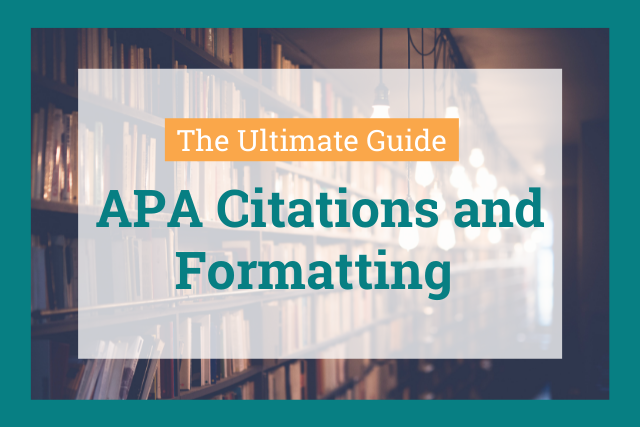
APA Style is one of the most common formats used for papers related to the social sciences.
The purpose of APA Style is to make sure all papers follow a standardized set of guidelines. This helps make them as clear and readable as possible.
If you’re writing an APA paper, you’ve come to the right place.
In this article, you’ll find a complete guide for how to use APA formatting for in-text citations, reference pages, title pages, and more.
How Do You Create an APA In-Text Citation?
When you use someone else’s work as a source in your own paper, you’ll need to include an in-text citation.
Let’s take a look at what in-text citations are for, and how to format them correctly.
What’s the Purpose of APA In-Text Citations?
In-text citations make your work more trustworthy by referencing other reliable sources.
When you use in-text citations, readers know you’re not pulling quotes and figures out of thin air. If they want to find out more about how those quotes and figures were created, they’ll be able to look up and read the original source.
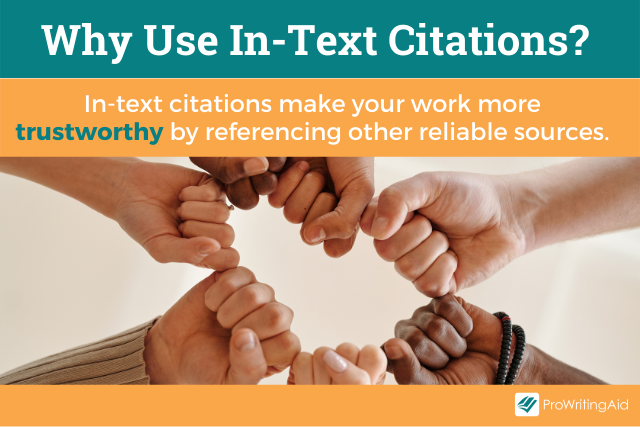
If you reference other people’s work without citing the source, you run the risk of plagiarism, which is when you claim others’ work as your own. Plagiarizing, even by accident, can jeopardize your reputation, so make sure to use in-text citations properly.
For extra help in avoiding plagiarism, sign up for ProWritingAid’s Plagiarism Checker. Unlike other plagiarism checkers, ProWritingAid will not store or share your work. Ever.

When Do You Need to Use an In-Text Citation?
You should use an in-text citation every time you do the following things:
- Use a direct quote (i.e. the exact words the source used)
- Paraphrase the ideas of someone else (i.e. give the information in your own words)
- Mention a fact or figure that isn’t common knowledge
- Refer to data
- Use someone else’s table or figure
- Use a long text passage from someone else’s work
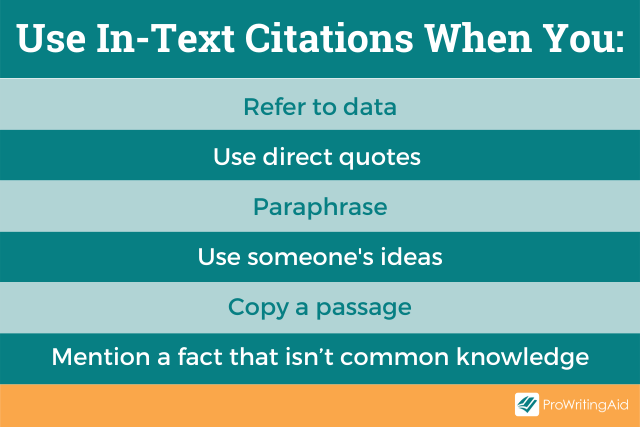
What Information Do You Need to Include in an APA In-Text Citation?
For every in-text citation, you need to provide two pieces of information: the last name of the author and the publication date.
If you’re using a direct quote, or a fact or figure from a specific page, you should also provide the page number that information is found on.
How Do You Format an APA In-Text Citation?
You should place the in-text citation immediately after the word or phrase it’s relevant to, rather than after a long paragraph or sentence.
You can reference sources using either parenthetical or narrative citations, depending on which one works better in the sentence you’re writing.
A parenthetical citation is when you write a normal sentence, and then include the author’s name and the year in parentheses. A narrative citation is when you mention the author’s last name within your sentence, as part of the text itself.
Let’s look at some examples from the universe of the Harry Potter series by J.K. Rowling.
Examples of parenthetical citations:
- It’s not a good idea to tickle a sleeping dragon (Scamander, 1927), because you might get burned.
- Medieval witches who were burned at the stake would just perform a basic Flame-Freezing Charm so the fire had no effect (Bagshot, 1947).
Examples of narrative citations:
- According to Scamander (1927), it’s not a good idea to tickle a sleeping dragon, because you might get burned.
- Bagshot (1947) claimed that medieval witches who were burned at the stake would just perform a basic Flame-Freezing Charm, so the fire had no effect.
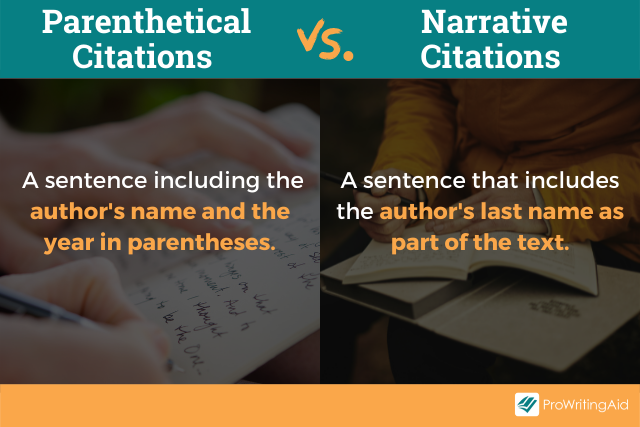
When possible, you should also include the page number the quote is found on.
Use the abbreviation “p.” for one page, or “pp.” for multiple pages, before listing the page number. For example, you might write (Bagshot, 1947, p. 129) or (Bagshot, 1947, pp. 129–131).
Example of parenthetical citations with page numbers:
- “Never tickle a sleeping dragon” (Scamander, 1927, p. 31).
- “Indeed, Wendelin the Weird enjoyed being burned so much that she allowed herself to be caught no less than forty-seven times in various disguises” (Bagshot, 1947, p. 129).
Examples of narrative citations with page numbers:
- According to Scamander (1927), one should “never tickle a sleeping dragon” (p. 31).
- Bagshot (1947) claimed that “Wendelin the Weird enjoyed being burned so much that she allowed herself to be caught no less than forty-seven times in various disguises” (p. 129).
What If a Source Has Multiple Authors?
If a source has two authors, include both of their last names in the in-text citation.
If you're using a parenthetical citation, use an ampersand between the names: (Name & name, year.)
Example:
- (Dumbledore & McGonagall, 1995)
If you’re using a narrative citation, write out the word “and”: (Name and name (year)...)
Example:
- Research by Dumbledore and McGonagall (1995) supports...
If a source has three or more authors, include the first author listed on the source, plus the words “et al.” (Name et al., year.)
The term “et al.” is short for the Latin term “et alia,” which means “and others.” You’ll often see it used in academic papers with multiple authors.
Examples:
- (Dumbledore et al., 1995)
- Research by Dumbledore et al. (1995) supports...
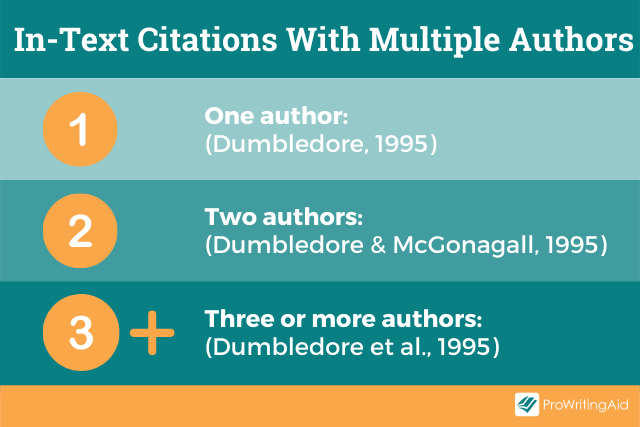
What If a Source Has an Unknown Author?
If a source has an unknown author, you can cite the source by its title instead of by its author.
Examples:
- A group of witches invented a spell to transform inert objects into living creatures (Intermediate Transfiguration, 1987).
- We learn in The Monster Book of Monsters (1999) that some creatures have extremely sharp teeth.
What If a Source Has an Unknown Date?
If a source has an unknown date, you can write “n.d.” (for no date) instead of the year.
Examples:
- A group of witches invented a spell to transform inert objects into living creatures (Intermediate Transfiguration, n.d.).
- We learn in The Monster Book of Monsters (n.d.) that some creatures have extremely sharp teeth.
How Many In-Text Citations Do You Need in Your Paper?
For most papers, you should cite one or two of the most representative sources for each key point.
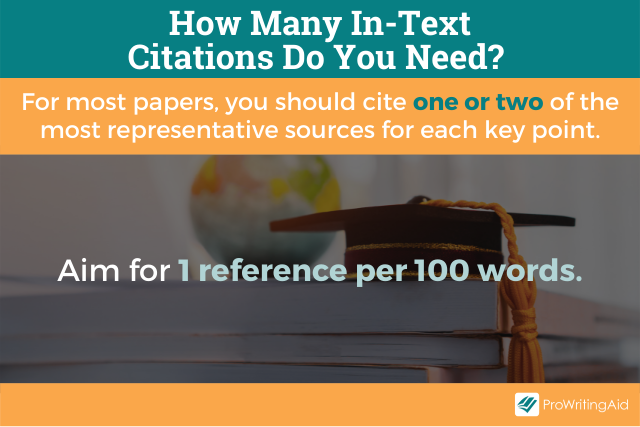
For example, if you state that 41 percent of Americans like the Harry Potter series, you should provide at least one source that also states that same number.
If you’re writing a literature review paper, you should include a more exhaustive list of references because you want to include all the most relevant sources for that subject.
How Do You Create an APA Reference Page?
The APA reference page is a section of your paper where you list each of the sources you use in your paper.
Let’s take a look at what the APA reference page is for and how to format it correctly.
What’s the Purpose of the APA Reference Page?
For every source you cite in-text, you also need to create a reference at the end of the paper with all the information necessary to find that source.
Your goal is to make it clear exactly which source you’re citing, with no room for ambiguity, so that anyone reading your paper can clearly track down every source you used.
Where Should You Put the APA Reference Page?
The APA reference page should be the last section of the paper. It should come right after the main body of your paper, before any appendices.
Which Sources Do You Have to Include on the Reference Page?
You need to create a reference entry for every source that you’ve cited in the text. Any time you quote another author or use another author’s facts and figures, you need to make a reference entry for that source.
Make sure you don’t include any sources you don’t cite, even if you read them for research. Every reference entry in your reference page should be used directly in an in-text citation.
You can include any type of source in your reference page: books, chapters, articles, reports, web pages, and more.
What Information Do You Need to Include in an APA Reference Entry?
APA references typically include information about the author, publication date, title, and source.
Other information may be necessary depending on the type of source you’re dealing with. For example, if you’re citing a web page, you may need to include the URL.
Here’s what a reference entry should look like for a book:
Author, A. A. (Year of publication). Title of work: Capital letter also for subtitle. Publisher Name. DOI (Digital Object Identifier) if available.
Book example:
- Bagshot, B. (1947). A history of magic. Little Red Books.
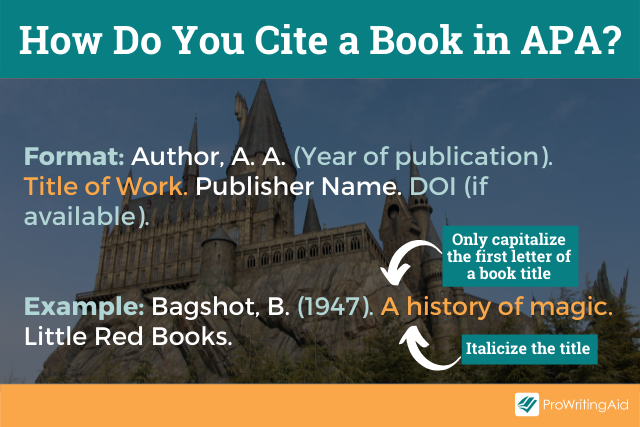
Here’s what a reference entry should look like for a web page:
Last name, F. M. (Year, Month date). Title of page. Site name. URL
Web page example:
- Stetka, B. (2014, September 9). Why everyone should read Harry Potter, Scientific American. https://www.scientificamerican.com/article/why-everyone-should-read-harry-potter/
How Do You Format an APA Reference Entry?
For the title, you should capitalize only the first letter of the first word of the title and subtitle, the first word after a colon or a dash in the title, and proper nouns. For example, you would say A history of magic, not A History of Magic.
Italicize titles of longer works (e.g. books, edited collections, names of newspapers, and so on).
Authors’ first and middle names should be written as initials. For example, the reference entry for a source written by Albus Percival Wulfric Brian Dumbledore would be written as "Dumbledore, A. P. W. B."
All lines after the first line of each entry in your reference list should be indented one-half inch from the left margin. This is called hanging indentation.
What If There Are Multiple Authors?
If there are multiple authors, you should list the last name and first/middle initials for all of them. Separate each author’s initials from the next author in the list with a comma, and use an ampersand before the final author’s name.
What Happens If You Don’t Know All the Information You Need?
If you don’t know all the information you need, don’t worry—you can still meet APA standards.
If the author is unknown, you can start the reference entry with the title, like this: Title. (Date). Source.
Example of a missing author:
- A history of magic. (1947). Little Red Books.
If the date is missing, you can write “n.d.” for “no date", like this: Author. (n.d.). Title. Source.
Example of a missing date:
- Bagshot, B. (n.d.). A history of magic. Little Red Books.
If the title is missing, you can describe the source you’re citing in square brackets, like this: Author. (Date). [Description.] Source.
Example of a missing title:
- Bagshot, B. (1947). [Textbook about the history of magic.] Little Red Books.
Are There Easy Ways to Generate APA Reference Entries?
Many online generators can be useful, especially if you’re citing a lot of sources.
Scribbr has an APA Citation Generator. You can just plug in the information, and it will generate the reference entry for you.
You can also use an editing software like ProWritingAid to make sure your capitalization and punctuation is consistent throughout your document.
How Do You Format Your APA Reference Page?
Your reference page should be double-spaced and in a legible font, such as Times New Roman 12pt, just like the rest of the paper.
On the first line of the page, write “References” as the title of the section. Make this word bold and center it on the page.
On the second line, list your reference entries in alphabetical order. Make sure they have hanging indentation, which means that the first line of each reference entry is aligned flush with the left margin, and each subsequent line has a hanging indent of 0.5 inches.
Reference list entries should be alphabetized by the last name of the first author of each work.
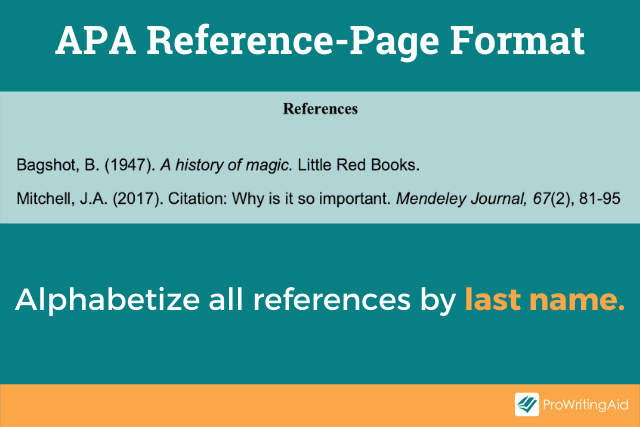
How Do You Create an APA Title Page?
The APA title page is the first page of your paper. On this page, you give all the key information about what your paper is for.
Let’s take a look at what the APA title page is for and how to format it correctly.
What’s the Purpose of the APA Title Page?
The title page ensures that all key information about your paper is presented upfront. With just a glance at the first page, a reader can easily figure out who wrote this paper, when it was written, and what it was written for.

What Are the Parts of an APA Title Page?
Every title page should contain the title of the paper, the author’s name, and the institutional affiliation.
Some components of the title page depend on whether you’re a student turning in a paper for a class or a professional turning in a paper to a journal.
A student paper should include the course number and name, instructor name, and assignment due date.
A professional paper should include the author note, which includes acknowledgments, disclosures, and the author’s contact information.
How Do You Format an APA Title Page?
The title should be centered with bold formatting applied, in the upper half of the page.
Beneath the title, type the author’s name: first name, middle initial, and last name. Don’t include any titles or degrees.
Beneath the author’s name, type the institutional affiliation—the location where the author conducted the research.
All text on the title page should be double-spaced, just like the rest of the paper.
Here’s an example of a student’s title page:
How to Transform a Needle into a Matchstick
Hermione Granger
Hogwarts School of Witchcraft and Wizardry
TRAN 101, First-Year Transfiguration
Dr. Minerva McGonagall
November 2, 1998
Here’s an example of a professional’s title page:
How to Transform a Needle into a Matchstick
Minerva McGonagall and Albus Dumbledore
Hogwarts School of Witchcraft and WizardryAuthor Note
We have no conflicts of interest to disclose.
Correspondence concerning this article should be addressed to Minerva McGonagall, 150 Hogwarts Drive.
What Is the Difference Between MLA Formatting and APA Formatting?
MLA and APA are two sets of guidelines for formatting papers and citing research.
MLA stands for the Modern Language Association. The MLA handbook is most often used in fields related to the humanities, such as literature, history, and philosophy. Check out our full guide to MLA formatting.
APA stands for the American Psychological Association. The APA manual is most often used in fields related to the social sciences, such as psychology, sociology, and nursing.
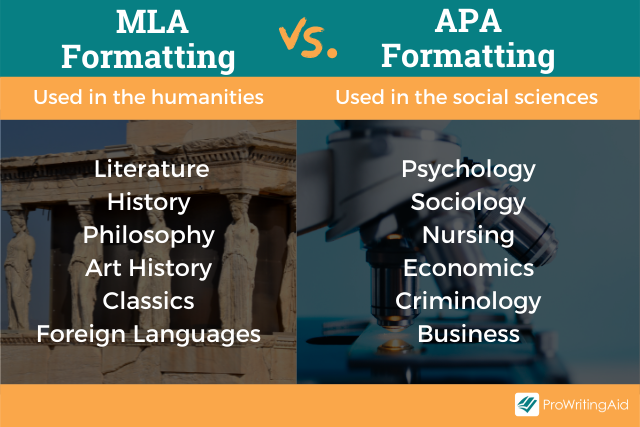
Where Can You Learn More About APA Formatting?
If you have questions about how to format a specific assignment or paper, it’s always best to consult your instructor or advisor first. If you’re a student, your school may also have a writing center that can help you with formatting questions.
Purdue’s website has fantastic resources for learning more about APA Style.
If you would like to find out more directly from the American Psychological Association, you can consult the Publication Manual of the American Psychological Association, 7th ed.
Final Words on APA Citation
Now you’re ready to write an APA paper.
Do you have any other questions about APA Style? Let us know in the comments.



